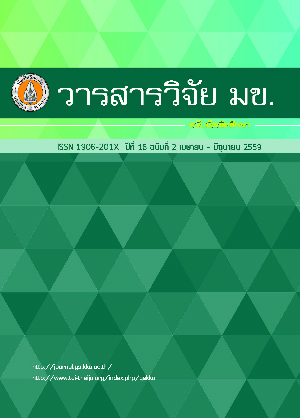การปรับปรุงระดับแรงดันไฟฟ้าสำหรับเทอร์โมอิเล็กทริกด้วยการจ่ายความร้อนแบบไม่ต่อเนื่อง (Voltage Level Improvement for Thermoelectrics using Discontinuous Heating)
Keywords:
เทอร์โมอิเล็กทริก (Thermoelectrics), การปรับปรุงระดับแรงดันไฟฟ้า (Voltage level improvement), ความร้อนแบบไม่ต่อเนื่อง (Discontinuous heating)Abstract
บทคัดย่อ
เทอร์โมอิเล็กทริกสามารถแปลงความร้อนเป็นไฟฟ้าได้โดยตรงโดยระดับแรงดันไฟฟ้าที่ผลิตได้ขึ้นอยู่กับความแตกต่างอุณหภูมิระหว่างด้านร้อนและด้านเย็นของเทอร์โมอิเล็กทริก แต่การจ่ายความร้อนแบบต่อเนื่องแก่ด้านร้อนโดยด้านเย็นไม่มีระบบรักษาความเย็นที่ดีระดับแรงดันที่ได้จะลดลง งานวิจัยนี้นำเสนอเทคนิคการปรับปรุงระดับแรงดันด้วยการจ่ายความร้อนแบบไม่ต่อเนื่อง ผลการทดลองพบว่า การจ่ายความร้อนแบบไม่ต่อเนื่องในช่วงอุณหภูมิ 40-100 องศาเซลเซียส ที่คาบเวลา 100-1,000 วินาที ให้กับเทอร์โมอิเล็กทริกโมดูลเดี่ยว ระดับแรงดันเฉลี่ยเพิ่มขึ้นร้อยละ 32.8-57.0 และ 82.1-114.5 สำหรับเทอร์โมอิเล็กทริกที่ด้านเย็นมีและไม่มีแผ่นครีบระบายความร้อน ตามลำดับ เมื่อเทียบกับการจ่ายความร้อนแบบต่อเนื่องในช่วงอุณหภูมิเดียวกัน การประยุกต์เทคนิคข้างต้นกับเทอร์โมอิเล็กทริก 2 โมดูลที่มีแผ่นครีบช่วยระบายความร้อน พบว่า เทคนิคดังกล่าวช่วยให้แรงดันลดลงเพียง 0.5-1 โวลต์ต่อชั่วโมง ซึ่งดีกว่าการจ่ายความร้อนแบบต่อเนื่องที่มีแรงดันลดลง 1-3 โวลต์ต่อชั่วโมง ผลการทดลองยังพบอีกว่า การจ่ายความร้อนแบบไม่ต่อเนื่องสามารถผลิตกำลังไฟฟ้าสูงสุดในช่วง 0.807-14.58 มิลลิวัตต์ ซึ่งสูงกว่าการจ่ายความร้อนแบบต่อเนื่องที่ให้กำลังสูงสุดเพียง 0.016-8.585 มิลลิวัตต์
ABSTRACT
Thermoelectrics can convert heat to electricity directly. The electric voltage levels generated by thermoelctrics are dependent on temperature difference between the hot sides and the cold sides of them. But continue heating hot sides of thermoelectrics without proper cooling systems can lead to the voltage level drop. This paper presents voltage level improvement for thermoelectrics using discontinuous heating. The experimental results showed that when applying discontinuous heating in the range of 40-100 °C with periodic time of 100-1,000 seconds to a single thermoelectric, the average voltage of the thermoelectric would increase 32.8-57.0% and 82.1-114.5% for of the thermoelectric with and without the heatsink, respectively; when compared to the continuous heating with the same temperature range. When applying this periodic heating technique for 2 thermoelectric modules with the heatsink, the results showed that the voltage levels would drop only 0.5-1 volts; which were better than the continuous heating that had the voltage level drop1-3 volts. In addition, the proposed discontinuous heating could generate electrical power in the range of 0.807-14.58 mW, which would be higher than the continuous heating that generated 0.016-8.585 mW.


